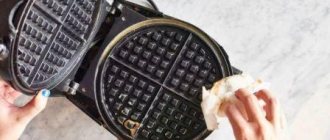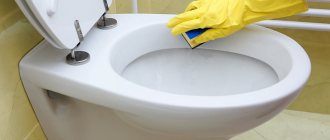When using it, persistent carbon deposits often form. This happens even when the device is used very carefully.
Special products and homemade recipes will help you cope with carbon deposits and restore the appearance of your oven. This article will tell you more about how to clean oven deposits.
Store-bought oven cleaners
The easiest way to quickly clean carbon deposits is to use special products. They are suitable for cleaning Bosch, Electrolux ovens and household appliances of other brands. Such products are specifically designed to remove old grease from the surface of built-in ovens. They can be used at home.
Such products contain acids or alkalis that remove stubborn fat without any effort. They are usually available in the form of a gel or spray, which can be easily applied to the inside of the oven. After applying them, wait 5 to 30 minutes. Then simply wipe the surface with a sponge. During this time, the carbon deposits will dissolve.
Pay attention to the following products that will help you easily wash away old fat:
- "Shumanite";
- Amway Oven Cleaner;
- "Shine";
- Faberlic;
- Sanita Anti-grease.
All these products are caustic, you need to work with them strictly according to the instructions, you need to take into account the cleaning time and method of application.
Be sure to use rubber gloves.
For example, let's look at how to clean an oven using Schumanite.
This is a caustic agent that can cope with any contaminants. It is often used by professional chefs. If you clean the oven with it at home, you need to proceed as follows:
- put on gloves, open the windows;
- apply the product to the walls, door;
- leave the oven closed for 5 minutes;
- remove with a soft sponge;
- rinse it with clean water.
If you don’t have such a product at home, you can take those chemicals that are often used. Sometimes housewives are interested in whether it is possible to clean the oven with Domestos. Use this product in the form of a cream and then thoroughly remove its remnants from the inside of the thermal chamber.
Where does plaque come from and why remove it?
Splashes of fat during cooking in the oven lead to the formation of carbon deposits on the internal surfaces.
The situation is aggravated by high temperature, condensation and evaporation . With repeated use of the oven, dense chemical compounds are deposited on the inner walls.
When the stove heats up, they begin to emit smoke, produce an unpleasant odor and substances harmful to health.
To prevent carbon deposits from forming, regular maintenance is necessary . This allows you to maintain the hygiene of the place in which food is prepared and to avoid the release of harmful and often dangerous compounds into the air. It will be much easier to cope with the task if you do not let the situation get worse and do not allow carbon deposits to accumulate.
How to clean an oven with vinegar and soda
Fresh dirt inside an electric oven can be easily washed off with baking soda and vinegar.
These are the most affordable means, they are in every home. The effectiveness of such cleaning is explained by the fact that these two substances enter into a violent chemical reaction, releasing carbon dioxide. It destroys the fat deposits inside the thermal chamber. How to clean the oven from old fat in this way?
- Make a paste with 2 tbsp. soda and 50 ml of water.
- Apply it in a thick layer on the doors, walls, ceiling and bottom.
- . Wait 1-2 hours.
- Without removing the baking soda, spray the inside with vinegar using a spray bottle.
- Wait for the reaction to subside, usually 15 minutes is enough.
- Rub with a brush and, if necessary, scrape off dirt with a spatula.
- Rinse the surface with clean water.
Please note: this is the most effective way to clean carbon deposits from the inside of glass.
Method 2. Quick
Now let's look at a way to clean the oven from grease using steam, acid or... regular dishwashing detergent. The method is suitable for cleaning a moderately dirty oven.
What you need:
- Citric acid, 70% vinegar or regular dishwashing detergent;
- Water;
- Deep baking pan or large bowl;
- Latex gloves;
- Sponge and damp cloth.
Instructions:
- Remove everything unnecessary from the oven: remove and set aside the baking sheets and everything else that is inside, but leave the wire rack in place - it will also benefit from a cleansing “bath”.
- Turn on the oven and leave it to heat up: you need to preheat the oven to 150-200 degrees.
- Pour water into a baking sheet and dilute citric acid in it: while the oven is heating up, pour water into a bowl or baking sheet and dissolve a sachet of citric acid (10-20 g) in it. Citric acid can be replaced with 1-2 teaspoons of vinegar essence or a small amount of dishwashing liquid.
- Place the baking sheet with the solution on the bottom shelf of the oven: place the baking sheet with the solution in the preheated oven on the lower tier. The bowl can be placed on the bottom.
- Leave the oven for 40 minutes: Leave the oven for 40 minutes, namely until the water boils and the oven door “fogs up”.
- Turn off the oven and leave the baking sheet to cool: when the water boils, turn off the oven and leave the baking sheet to cool for about 30 minutes.
- Clean the oven and rack: When the pan is cool, take a damp cloth and give the oven walls and rack a good wipe. As necessary, use the hard side of the sponge, spray with water, and soda or the same citric acid to remove old stains of grease and carbon deposits.
- Return the baking sheets and wire rack to their place: Woo-ala! The oven shines again and inspires culinary exploits.
How to clean the oven with ammonia
One of the most effective ways to clean glass and oven doors is to use ammonia. It is not very pleasant, as this product emits a pungent odor. But if all protective measures are taken, it will not cause harm. The effectiveness of ammonia against carbon deposits is explained by the fact that its vapor softens fat.
You will need 5 regular bottles of ammonia; they are poured into a small bowl. You need an even larger bowl of boiling water. How to clean fat using ammonia?
- Preheat oven to 1800, turn off.
- Place a saucepan with boiling water on the bottom and a bowl of ammonia on the grill.
- Close the door and leave for half an hour.
- If the plaque is old, you can leave it overnight.
- Clean off dirt with a sponge and baking soda.
- Rinse all surfaces clean.
When using this method, be sure to open the window in the kitchen. It is advisable not to inhale ammonia fumes as they are toxic.
Methods for cleaning the oven
There are several ways to clean your oven:
- Classic or traditional - mechanical cleaning by hand using all kinds of detergents.
- Pyrolytic - the oven heats up to 400 degrees, all dirt turns into ash, after which you can simply wipe it off with a napkin. Human participation is not required in the pyrolysis process.
- Catalytic - the coating of the oven walls contains a catalyst, which, when heated, decomposes fats that fall on the enamel of the coating.
- Hydrolysis – well known to every housewife – cleaning using water steam, which softens dirt. To do this, just place a container of water in the oven and heat it to approximately 90 degrees.
Each of these methods has its pros and cons. For example, the classic method is good because:
- Simple and inexpensive - you can put the oven in order using ordinary improvised means, we will talk about them later.
- This cleaning method does not in any way affect the taste of the prepared dishes.
- Does not require electricity consumption.
But this method has more disadvantages:
- labor-intensive process;
- takes a lot of time;
- trays and grates are cleaned separately;
- the surface may be damaged.
And yet, while this “grandmother’s” method is the most common - not everyone has “sophisticated” ovens with a self-cleaning system - let’s talk about it in more detail.
How to clean the oven with peroxide and soda
These substances are also available and found in every home.
When they are combined, an effective product is obtained that removes grease from any metal and enamel surfaces. Therefore, it can be used when the question arises of how to clean the oven grates, tray and walls. The cleaning method is very simple. Mix baking soda and hydrogen peroxide to form a paste. Using a brush or sponge, apply it to all dirty areas. Depending on the degree of contamination, you need to leave it in this form for 20-40 minutes. Scrub afterwards with a brush, and then rinse off with water.
General recommendations for cleaning the oven
The inner surface of the oven is located close to the food being prepared. This is why many women avoid using harsh cleansers. If particles get on food, they can pose a health hazard. Many housewives are not ready to use chemicals.
When cleaning the oven, folk recipes can also be used, the effectiveness of which is not inferior to household chemicals. The ingredients for such cleaning are present in every home. Following DIY cleaning rules is important.
Recommendations:
- Regular cleaning is important; removing old stains is much more difficult.
- Using protective gloves will help protect your hands from the harmful effects of chemical components. They should be worn even when using gentle products. Dirt, soot, and greasy residues have a negative impact on the condition of the skin of the hands. It is recommended to immediately wash off any cleaning products that come into contact with your hands from your skin with plenty of water.
- When cleaning the oven, it is not recommended to use abrasives and metal sponges; this will help avoid damage to the surface.
- Reading the instructions will help you do everything correctly. Self-cleaning ovens do not require the use of cleaning products or household chemicals.
- Removing chemical residues with water will help prevent them from getting into your dishes.
- Airing the oven after cleaning will help enhance the effect.
How to clean the oven with citric acid
This is the fastest way to help clean glass, walls, and baking trays until they shine. If the stains are not strong and fresh, then you can take lemon juice. Use it to wipe all surfaces or spray it with a spray bottle. Leave for half an hour, rinse with water. You can mix the juice in equal parts with water or wipe the stains with a slice of lemon.
The second method is suitable for stubborn stains. Heating is used for this.
- Preheat oven to 1500.
- Place a baking tray or bowl with water in which citric acid is dissolved
3. Heat this solution for 30-40 minutes.
4. Cool and wipe with a sponge. If some stains persist, clean them with baking soda.
To maintain the correct proportions, you need to add 1 sachet of citric acid to 500 ml of water.
Video; how to clean an oven easily and cheaply
Cleaning Recommendations
The most important thing is to avoid the formation of grease and carbon deposits, you need to wash the oven immediately after cooking. Moreover, it must be hot, then the plaque is easier to clean. If the oven is used frequently, it is recommended to periodically steam it with water and dishwashing detergent. And in the case when you have to use aggressive methods, use simple tips:
- do not use steel wool, scrapers or other abrasives that can damage the surface;
- do not apply cleaning agents to the fan or heating elements;
- rinse the inside surface well and ventilate the oven, especially after using products with a strong odor;
- If the smell remains, place a container with crushed activated carbon tablets inside.
Cleaning the oven from carbon deposits and stubborn grease is not difficult; there are many accessible ways to do this. But it is better to prevent such contamination by cleaning it after each cooking.
Household chemicals: what to choose and how to use?
A large number of different products are produced by domestic and foreign manufacturers for cleaning ovens . Such preparations allow you to clean faster than some home recipes, and without the unpleasant odor that is typical, for example, of ammonia and vinegar.
Oven cleaning products are available in various types. These can be powders, aerosols, gels, etc.
When choosing a specific drug, you should consider the following points:
- Price.
- Smell. The less pronounced it is, the better. This will allow you to be sure that the foreign aroma will quickly disappear and will not affect the prepared dish in the future.
- Compound. Most drugs contain components that are caustic to the skin. It is prohibited to use such products without gloves. If there is a note about environmental friendliness on the packaging, the composition is harmless and contains natural ingredients.
Oven cleaner Sano Forte Plus
Sano concentrated product is suitable for removing carbon deposits, including old ones. In addition to ovens, it can be used on microwaves, stoves and grills. Suitable for caring for ceramic surfaces. The cleaning agent produces foam when applied using a spray bottle.
Advantages of the drug:
- has no pungent odor;
- acts in minutes;
- copes with old fat deposits;
- gives highly efficient processing.
The downside is the price, about 600 rubles per bottle. Read reviews here and here.
Sanita grease remover
The product is available in liquid form and is applied by spraying onto metal and glass-ceramic surfaces. The grease remover is suitable for removing old fat. When applied, the drug forms foam.
Advantages of the grease remover:
- easy fat breakdown;
- easy rinsing;
- gives a scent of purity;
- safe for hand skin;
- affordable price;
- leaves no streaks.
Minus: the spray may not cope with old carbon deposits the first time. The average price is from 200 rubles. Read reviews here and here, here and here, here.
HG
When applied, the drug forms abundant foam. Can be used to care for grills, stoves and ovens.
Advantages of the product:
- suitable for regular cleaning and for removing old carbon deposits;
- good foam formation;
- fast action;
- efficiency.
Minuses:
- high price;
- the need to put in effort when cleaning.
Price - about 500 rubles per bottle. Read reviews here and here, here and here.
How to prevent the formation of greasy stains and carbon deposits
The best way to clean an oven is prevention. Only regular use of a thick baking sleeve will help reduce the appearance of greasy stains. If cooking by hand is not suitable, you should try to wash the oven with a sponge and dishwashing detergent after each use.
The key to cleanliness is cleaning after each cooking.
Store-bought products will also help to clean the oven; “heavy artillery”, which contains alkali or acids, works best. You can use folk and industrial remedies together, not forgetting that you need to work with gloves.
General rules
Before general cleaning of your kitchen stove, please read these simple rules:
- When starting cleaning, turn off the gas and/or turn off the power to the stove.
- First of all, brush away all the debris - pieces of soot, food crumbs, dust - so that only those contaminants remain that we will wash.
- Removable burners can be washed separately: they can be pre-soaked in a basin of hot water.
- Everything is allowed to be washed except the heating elements.
- Do not use hard, especially metal, brushes and sponges to clean off the slag from the stove. Not only will they leave permanent scratches, but fat will accumulate there, which will be difficult to remove from this micro-groove.
- Make it a rule to finish cleaning not only by washing the contaminated surfaces, but also the entire stove.
Use only soft brushes
Preparation
Before you start cleaning at home, you need to do some preparatory procedures, in particular:
- Keep children and pets away from the kitchen as they may inhale harmful fumes or get burned.
- Be sure to wear gloves - aggressive chemicals cause dryness and irritation of the skin. If contact occurs on exposed skin, immediately wash the area with soap and water.
- Wear a gauze bandage or a respirator when working with strong-smelling substances.
- Provide a flow of fresh air - open a window, turn on the hood.
- Remove all removable parts from the oven: baking sheets, racks, some models have removable walls. It is much easier to wash them in the sink or bathtub. If possible, remove the door - it will be much more convenient to clean the inside.
- Before any processing, preheat the oven at 50 ℃ - this will soften fat and carbon deposits and help them move away from the walls more easily.
- Do not use hard abrasive sponges or metal scrapers for cleaning. They can easily damage the enamel.
There are devices with a self-cleaning function. These can be gas ovens or electric. With them, life is wonderful: we just press a button and no pain. The equipment will do everything itself, all you have to do is wipe off the residue with a damp cloth. Therefore, even at the stage of buying an electric oven or gas oven, think about whether it might be worth overpaying, but saving yourself from the painful responsibility.
If your device does not have such an option, then do not worry, you are quite capable of dealing with dirt.
Self-cleaning programs
Many models are equipped with automatic cleaning programs. Depending on the model and price category, you can find the following types:
- steam Fat deposits are softened by steam and then removed;
- catalytic. Fat decomposes into water and soot under the influence of temperature due to the operation of the catalyst. Cleaning works in the temperature range from 150 to 250 ˚С, i.e. almost always when the oven is turned on and food is being cooked in it;
The self-cleaning cycle must be periodically started in an empty oven, setting the temperature to 250˚C.
- pyrolytic. Fat deposits are burned in the chamber under high temperature. During self-cleaning, the internal surfaces of the oven heat up to 480–500˚C. Then all that remains is to remove the resulting ash.
For safety reasons, the oven door is locked while the program is running. It will be possible to open it only when the temperature drops to safe values.
Why is it necessary to clean your oven regularly?
When cooking any dish in the oven, splashes, grease and condensation with an odor settle on all internal surfaces of the oven.
When exposed to high temperatures, these organic compounds melt repeatedly, changing their structure, and harden, literally eating into the walls. When they burn again, they also release smell and fumes, which, in turn, saturate both the oven itself and the dish you are preparing. Agree, treating yourself to a charlotte with the obvious smell of yesterday’s chicken with garlic sauce is a little pleasure!
To avoid such problems, the oven walls and all other oven surfaces must be cleaned regularly.
The ideal option is to carry out this cleaning of carbon deposits and grease every time after using the oven, as soon as it has cooled down sufficiently. In this case, you will never encounter old grease and unpleasant odors inside.
But, of course, in conditions of constant rush and limited time, not every housewife manages to do this so often. The most realistic option is to clean the oven as it gets dirty. So, if you use it frequently, make it a rule to clean it once a month.
How to prepare your oven for cleaning
Strong substances are used to clean ovens from burnt fat and food residues. To prevent them from damaging the rubber bands, you need to remove them.
Even a very dirty and smokey oven can be cleaned. You need to know what and how
- First of all, disconnect the oven from the power supply. Even if it is gas, but with lighting and electric ignition. Either turn off the circuit breaker at the supply line or remove the plug from the socket.
- Then we take out the grates and baking sheets. If they are stainless steel or enamel, you can use the same cleaning products you use for ovens. But you can do this in the sink. Aluminum and galvanized ones require gentle products.
- There may be removable side guides. In some gas stove ovens, the side walls can also be removed. If you take them off
- On the oven door, remove the rubber seal from the grooves. As a rule, it is held in place by protrusions on the back side. So you can pry it with something flat (not a knife, better a screwdriver or a nail file) and pull it out.
To prevent oven cleaning products from damaging the rubber, remove the sealing cord from the door
The holes that were open after removing the seal must be closed with something. Pieces of electrical tape or adhesive tape will do. This will prevent cleaning products and dirty water from getting inside the door.
What you need
Use rubber gloves with long sleeves and thick rubber. Before work, open a window (window) and use a mask or construction (medical) respirator.
For work you need good rubber gloves, rags, sponges and water
How to get rid of fruit midges in an apartment: effective ways and methodsWhat to do if your kitchen sink is clogged: how to clear the clog yourself
Installing a siphon under a kitchen sink with your own hands: assembly and connection diagram
Also, to clean the oven you will need kitchen sponges, rags or porous, highly absorbent napkins/cloths for cleaning. You may need metal scrapers (stainless steel) or hard sponges. A bucket of water that can be changed several times.
Causes of pollution
Contaminants appear during cooking. Only by knowing the exact reasons can you prevent severe contamination and understand how best to clean the gas stove grate. Cooking is not always a neat process. Food particles, grease, and escaped water fall on the stove. The more dirty it is, the more difficult it is to clean the grate of a gas stove; cleaning it becomes an almost impossible task. At the same time, it can become dirty more than once a day, which requires additional cleaning of the gas stove grates to remove carbon deposits. And if you don’t clean it, each layer of dirt will be absorbed more and more firmly into the rods, forming soot, which over time will turn into solid scale. Knowing how to quickly clean a gas stove from grease, such contaminants can be removed in a timely manner and without much effort. Make it a rule to wipe the rods with a damp sponge after each meal preparation. If quite a lot of dirt has accumulated, you can use one of the methods suggested below.











